In theaters and on other screens
It’s a heavy week of movie offerings. Not only do we have three—well, two-and-a-half—mainstream releases and two not-so-mainstream ones, but there are four non-theatrical screenings in the offing. If nothing else, that gives viewers a pretty wide array of choices.

On the mainstream front the biggest movie would seem to be Judd Apatow’s Funny People with Adam Sandler and Seth Rogen—not to mention Jason Schwartzman and Jonah Hill. While Apatow’s name has been all over the comedy genre for the past few years, Funny People is only his third directorial effort. It also looks to be his most ambitious in its attempt to blend comedy with more serious concerns. Whether that’s going to pay off remains to be seen. The early reviews have been positive, but most of them also remark on an uneven tone, a clunky structure and an excess of footage (the film runs either 140 or 145 minutes according to various sources). Regardless, whether you love him or hate him, Apatow is undeniably a major figure in pop culture—even if his exact importance as a filmmaker remains to be seen—making Funny People is hard to ignore.
My guess is that it’s OK to ignore Aliens in the Attic, the trailer for which looks pretty God-awful. That hasn’t kept it from being heavily booked, which isn’t much of a shock because we live in an age when even the most mentally defective tosh seems to sell if it’s aimed at kids. Of course, Aliens might turn out to be an agreeable surprise. That doesn’t mean I hold out much hope, but it could happen.
The new horror picture, The Collector, seems to be sneaking into town with little or no fanfare (which is why it qualifies as only half a mainstream release).That tends to happen when your movie comes out from Freestyle Releasing, whose aegis festoons a lot of negligible, barely released fare like Nobel Son (2008), The Haunting of Molly Hartley (2008) and Uwe Boll’s In the Name of the King: A Dungeon Siege Tale (2007). They got lucky once with The Illusionist (2006). That they will get lucky again with a picture by the guys who wrote the last couple Saw pictures seems like a long shot.
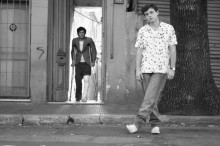
Far more interesting than any of these are the week’s more specialized offerings: Kathryn Bigelow’s The Hurt Locker and Francis Ford Coppola’s Tetro, which open at the Asheville Carolina and the Fine Arts Theatre respectively. Reviews for both will be in this week’s Xpress, but I’ll say this much now: If you’re really into movies, you need to see these films. Bigelow’s movie is the first film about the war in Iraq that really works, while Tetro is the best thing Coppola has done since Apocalypse Now (1979)—and the most gorgeous film he’s ever made.
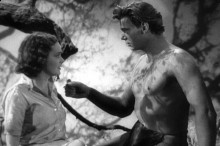
While the non-theatrical screenings we normally have—World Cinema and the Hendersonville Film Society—had already been augmented by the Wedge Brewery’s Outdoor Cinema series for a while now, a fourth series appears this week. This newcomer is a series of four movies being shown on Saturday nights in honor of the founding of Pritchard Park in 1932 in downtown Asheville. As a result, the films being shown in the park were all originally released in 1932 (a year that gets my vote as being far richer than the more celebrated 1939). First up is W.S. Van Dyke’s Tarzan the Ape Man. I think it’s likely you all know what that is, but it’s worth another look just to see what made the Weissmuller Tarzan movies so popular for the next 16 years.
If all this isn’t enough for you, Whatever Works and Moon are still holding at the Fine Arts (in split shows come Friday), and Cheri and Summer Hours (review in this week’s paper) continue at the Asheville Carolina. Up is also still loitering at the Carmike 10. It’s only in 2-D now, but that doesn’t change its quality. If you have missed these, you should consider squeezing them in while the opportunity remains.
On DVD
If you managed to miss Fast & Furious and Dragonball: Evolution in the theaters, here’s your chance to catch up with them on DVD. Personally, I’d just count my blessings and move on—even if Dragonball: Evolution has some merit in the so-bad-it’s-good category. Either one, however, is preferable to encountering the magnificently unfunny Miss March, which emptied theaters at an alarming rate a little while back. The promise of extra footage in this “unrated edition” is about on par with being offered two more days of swine flu.
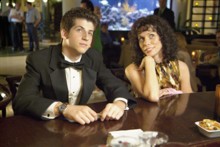
On an altogether brighter note is Bart Got a Room, a sweet-tempered, often very clever little comedy with an unusual—and unusually well-used—south Florida location. The appealing teenage stars in this tale of prom-going angst find nice support from the likes of William H. Macy, Cheryl Hines and Jennifer Tilly. La Tilly has only one scene, but it’s a good one. If the film sounds vaguely familiar, that might be because it took the Best Picture award at last year’s Asheville Film Festival.
The more esoteric releases include the Criterion release of Roman Polanski’s English-language debut film Repulsion (1965). It’s certainly nice to see Repulsion given the Criterion treatment, but isn’t it time someone brought Polanski’s follow-up film Cul-de-sac (1966) to DVD? After all, Polanski only made Repulsion so he could make Cul-de-sac in the first place.
This week also finds a multi-disc set on the evolution of comedian-director Charley Chase called Becoming Charley Chase. I confess that I know Chase primarily from his two-reeler talkies (and his appearance as Ollie’s jokester brother-in-law in the 1934 Laurel and Hardy feature Sons of the Desert), so I can’t really weigh in on this set. Perhaps Chip Kaufmann will stop by and add his take on this set of silents.
And just in time for the August release of Quentin Tarantino’s Inglourious Basterds (misspellings intentional) we have Enzo G. Castellar’s original exploitation film The Inglorious Bastards (1977) with Bo Svenson and Fred Williamson. This is the film that inspired Tarantino’s new work. I’ve never seen it, but it ought to prove interesting for comparison purposes at the very least.
Notable TV screenings
Once again about the best thing that can be said about the Fox Movie Channel is that they aren’t showing Dunston Checks In, but there are at least signs that their August listings may yet bring us something new. In the meantime, there’s always Turner Classic Movies, which offers at least a few delights this week.
Pre-code musicals TCM, Wednesday, July 29, starting at 8 p.m.
Hips Hips Hooray (1934), Golddiggers of 1933 (1933), Footlight Parade (1933), Fashions of 1934 (1934) and The Good Companions (1932)
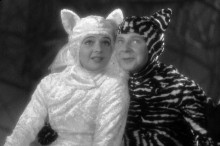
A lot of these titles crop up pretty frequently on TCM, but I’m not likely to complain about any showing of Golddiggers of 1933 or Footlight Parade. And both are certainly very much pre-code. The dialogue and the skimpy costumes attest to that. By the middle of 1934 neither film could have been made without significant changes. Footlight Parade even goes so far as to make fun of censorship by giving Hugh Herbert the role of an on-site censor, who offers such useful guidelines as, “You better put brassieres on those dolls,” and insists that a musical number with alley cats can only have kittens if the adult cats are married by a preacher cat. (He also gets caught in a tryst with James Cagney’s faithless fiancée, but he was, of course, only showing her “what you can’t do in Kalamazoo.”) Perhaps the real surprise, though, is the “Shanghai Lil” number with its obvious prostitutes and scenes of chorus girls smoking opium.
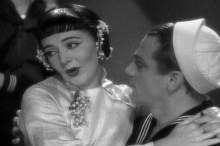
The most interesting aspect of this set, however, is the appearance of Victor Saville’s The Good Companions with Jessie Matthews, Edmund Gwenn (yes, Kris Kringle from the 1947 Miracle on 34th Street) and a very young John Gielgud. You’ve probably never heard of this film, which to the best of my knowledge has never shown up on TCM. Actually, it’s never turned up anywhere within range of me—and I’ve been looking for it for at least 30 years. It showing up here is the sort of thing that keeps hardcore cineastes carefully scouring movie listings.
The Good Companions is based on a once very popular novel by British writer J.B. Priestley. It was in fact the most popular book the prolific Priestley ever wrote. Priestley himself found it something of an albatross since, as he put it, “I’ve spent my life being criticized by some for never writing anything else like it, and being criticized by others for having written it in the first place.” It’s actually a very charming comic novel about a traveling group of players called the Dinky Doos. And it’s not without literary merit—especially in terms of structure—but it’s very much a crowd-pleaser affair. As indicated, I’ve never seen the film (nor the 1957 remake of it). I assure you, however, that I will be watching Wednesday night at 2:30 a.m. (that’s Wednesday night into Thursday morning, working on TV Guide time) when it shows.
Twentieth Century TCM, Thursday, July 30, 7:15 a.m.
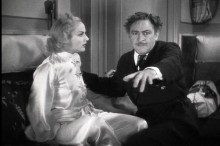
The legendary John Barrymore teams with the equally legendary (after this film) Carole Lombard in this 1934 Howard Hawks film about an egomaniac Broadway producer and his rocky romance with the star he created—and lost due to his overbearing jealousy. There may be funnier films, but I’m hard-pressed to think of one. It starts a little slowly, but the payoff more than makes it worthwhile. I’ve seen this several times with audiences at rep house screenings, and it’s always the same—mild amusement up to the point that we see the chalk marks Barrymore has laid down on the floor to show Lombard how to move through the play they’re rehearsing. From there, it’s solid laughs all the way. Both stars are at their very best. As film historian John Baxter once wrote, “with this one performance Barrymore justifies his immense reputation.”




Is The Collector an adaptation of John Fowles’ book?
Once again about the best thing that can be said about the Fox Movie Channel is that they aren’t showing Dunston Checks In
I have yet to get around to seeing Dunston Checks In. Worth tracking down? I don’t have American cable, so the case of Dunston Checks In Fatigue has yet to strike me. I did, however, see the made-for-tv sequel, where the title character relocates to a Central European republic and opens a small hotel: Dunston’s Czech Inn.
While I have yet to work my way through all of BECOMING CHARLEY CHASE (its 4 DVDs total over 450 minutes), what I have seen looks to be in remarkably good shape considering the age and the rarity of the material and what it reveals is truly remarkable.
Charley Chase began his career as Charles Parrott at Keystone in 1914 where he worked with Arbuckle, Normand, and Chaplin in small unbilled parts. He turned to direction at roughly the same time and went to work for Hal Roach in the early 1920s where he met a young fellow named Leo McCarey. Together they made a 1924 short called SITTIN PRETTY which has an almost identical version of the mirror gag McCarey would later make famous in DUCK SOUP (It features Charley and his younger brother James Parrott who would also become a comedy director).
He became Charley Chase (hence the name of the set) to separate the comedian from the director. His onscreen character bears a remarkable resemblance to Dick Van Dyke who must have been familiar with Chase’s comedies. It was based on a once popular comedian named Lloyd Hamilton. He became Roach’s number one star until he was eclipsed by Laurel & Hardy in the late 20s (they remained good friends). He continued to act and direct (at Columbia including a few 3 Stooges shorts in the late 30s like VIOLENT IS THE WORD FOR CURLY) until his early death in 1940 at the age of 46.
This set has been years in the making as some of the pre-Roach material was very hard to come by and there were legal complications over who was going to release it. It shows that Chase had a tremendous influence on screen humor directing it away from outright slapstick and more into situational comedy. It’s amazing how much of his late teens and early 20s stuff got recycled by others (including Stan Laurel). I can’t wait to finish the set but it will take time. My initial reaction is one of admiration tinged by a touch of sadness over how he has been forgotten. Hopefully this set will change that.
Is The Collector an adaptation of John Fowles’ book?
No. You need the 1965 William Wyler picture for that.
I have yet to get around to seeing Dunston Checks In. Worth tracking down?
It is highly regarded among orangutan and Faye Dunaway completists, I believe.
My initial reaction is one of admiration tinged by a touch of sadness over how he has been forgotten. Hopefully this set will change that.
Thanks for weighing in on the set. I felt certain you’d have it. I’ve liked the Chase silents I’ve seen, but I’m unregenerate in a basic preference for talkies and would love to see his sound Roach shorts come out. Granted, you can occasionally catch one on TCM. The problem is that they’re added into the programming much later than the original listings, so the only way to know one is on is to constantly keep checking the website listings. In fact, the 1936 Charley Chase short Neighborhood House is on TCM on Friday, July 31 at 5:35 p.m.
They still haven’t shown — or I keep missing — Public Ghost No. 1 (1935), which is a must-have for the scene in which the great Edwin Maxwell demonstrates his Simplex Fly Exterminator to Charley.
Love Charlie Chase. He also appeared in one of Laurel and Hardy’s finest features, “Sons of the Desert”. I love slap stick. Yesteryear, as well as today. Today, “Dumb & Dumber” gets a nod from me as carrying on the tradition of this type of humor.
Today, “Dumb & Dumber” gets a nod from me as carrying on the tradition of this type of humor.
Uh…no.
I’m still waiting for someone to comment on my Dunston’s Czech Inn gag.
I’m still waiting for someone to comment on my Dunston’s Czech Inn gag.
Well, it made me groan, which I presume was the intent.
Well, it made me groan, which I presume was the intent.
It’s hard to get a contemptuous eye roll across in print, I suppose. I shouldn’t have expected much.
It’s hard to get a contemptuous eye roll across in print, I suppose. I shouldn’t have expected much.
Set yourself a goal — see if you can provoke me to say to you, “Somewhere an electric chair is waiting.”